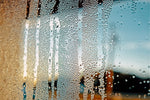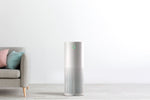Do Air Purifiers Help with Mold? Yes, But Not Alone

Yes, they do! But they are just tools in your arsenal of several measures against mold. You will also need to control moisture, fix leaks, and clean the mold itself.
Shortly, that’s how air purifiers and their filters work against mold:
- Air purifiers reduce airborne mold spores.
- HEPA filters capture up to 99.97% of fine particulates (which includes mold spores).
- Activated carbon filters help with odors.
- Place air purifiers in high-risk areas (like basements).
- Run them 24/7 for best results.
- Regularly replace or clean filters as per manufacturer’s guidelines.
Still, use air purifiers as part of a broader mold management plan, including controlling moisture and cleaning mold.
Let’s now tackle this step-by-step:
- First, we’ll figure out just how dangerous mold can be.
- Next up, we’ll learn the best ways to combat it.
- Finally, we’ll find out how to make it disappear.
So, keep reading to get a more comprehensive answer to the question: Do air purifiers help with mold?
Invisible Danger
Mold isn’t just a nuisance—it's a serious health hazard. Ignoring mold can lead to severe and potentially life-threatening health issues. Mold is a common problem for about 47% of residential buildings in the United States. Unfortunately, many people only start addressing this issue when health problems come up. The effects of mold on your health can be alarming and far-reaching.
Respiratory Issue
Mold spores can invade your lungs and cause:
- Persistent coughing
- Wheezing
- Shortness of breath
For people with asthma or chronic lung conditions, mold exposure can trigger asthma attacks.
Infections and Diseases
Certain molds, like Aspergillus, can cause dangerous infections in the lungs. Prolonged exposure may lead to serious conditions like aspergillosis. It can be life-threatening, especially for individuals with weakened immune systems.
Allergic Reactions
Mold can provoke intense allergic reactions, including sneezing, itchy eyes, and a runny nose. In severe cases, it can trigger life-altering conditions such as allergic rhinitis or hypersensitivity pneumonitis.
Skin and Eye Irritations
Exposure to mold can lead to itchy, red eyes and skin rashes. Mold spores can aggravate conditions like eczema, making skin problems even worse.
Mental Health Decline
The stress of living in a mold-infested environment can severely impact mental health. It can lead to anxiety, depression, and social isolation. All due to unpleasant living conditions and health concerns.
Increased Risk for Vulnerable Groups
Children, the elderly, pregnant women, and other vulnerable groups with compromised immune systems face higher risks from mold exposure. The health impacts on them can be particularly severe. It can affect their overall quality of life and lead to serious health complications.
So, if you’ve spotted mold in your household, it’s better to fight it quickly to protect your health and well-being.
Best Measures Against Mold
Combatting mold requires a multi-faceted approach to tackle the problem from various angles. Here are three essential strategies to manage mold in your home.
-
Control Moisture and Address Leaks
Mold thrives in damp environments. That’s why controlling moisture is key to preventing its growth. Here’s how you can do it:
Repair any leaks in pipes, roofs, or windows.
Use dehumidifiers and keep indoor humidity levels between 40% and 50%.
Provide fresh air circulation.
- Clean and Remove Existing Mold
If you find mold in your home, clean and remove it as quickly as possible. Ignoring even small mold patches can lead to larger infestations. These are a few steps to clean and remove mold:
Conduct regular mold inspections.
Use mold cleaners for small patches.
If you have a significant mold problem, seek professional mold remediation services.
Use anti-mold solutions to apply to walls, ceilings, and other surfaces to reduce the risk of mold returning. - Use Air Purifiers
Do air purifiers help with mold? Absolutely!
Air purifiers play a critical role in managing mold in your home. They improve indoor air quality and reduce airborne mold spores. Besides, they are a good add on to the above-mentioned measures, since mold needs a complex solution.
Let’s explore more how air purifier helps with mold.
How Air Purifiers Help Against Mold
Mold releases tiny spores into the air that people can inhale. These spores can become airborne and enter your lungs. There, mold spores may irritate and lead to various health issues. We've already discussed them earlier.
Air purifiers clean the air by removing pollutants, allergens, and particulates. They use various types of filters to trap airborne contaminants. For mold-related issues, you need air purifier with HEPA filters like Jaspr.
Finally, activated carbon filters in the Jaspr air purifiers can absorb odors and VOCs released by mold. Thus, they reduce the musty smell often associated with mold growth.
In short, air purifiers don’t eliminate the mold. But, they can make the home more comfortable, safer, and pleasant to live in.
Maximize the Effectiveness of Your Air Purifier Against Mold
To ensure that your air purifier works at its best, follow these tips to maximize its effectiveness:
Place the Air Purifier in High-Risk Areas
To maximize mold removal, strategically place your air purifier where mold is most likely to thrive. Mold grows in areas with high humidity and poor ventilation, such as:
- Bathrooms
- Basements
- Kitchens
- Laundry rooms
While these are the common areas where mold tends to develop, it’s important to note that Jaspr air purifiers are meant to be used as a full-home system. Instead of placing a single purifier in areas like bathrooms or laundry rooms (which actually sounds obvious), it’s recommended to position multiple Jaspr units throughout the main areas of your home, such as kitchens, bedrooms, and living rooms. This ensures consistent air quality improvement across the entire house.
Position the air purifiers near these mold-prone zones and in the primary living areas for the best results. Also, ensure the purifier is not blocked by furniture or walls, as proper airflow is essential for capturing airborne mold spores.
Optimize Air Circulation
An air purifier works best when it has adequate airflow, allowing it to draw in and filter as much air as possible.
- Leave doors open to let air move freely between rooms. This helps the purifier pull in spores from surrounding spaces. It's better to choose devices suitable for both small and big spaces.
- Mold spores are constantly floating through the air. So, keeping the purifier on 24/7 ensures consistent filtration. Therefore, it's better to find a device with whisper-quiet technology like Jaspr.
Regularly Replace or Clean Filters
Air purifiers rely on clean filters to function efficiently. Over time, HEPA and activated carbon filters can become clogged with particles. This reduces their ability to capture mold spores.
Check the manufacturer’s guidelines for how often you should replace the filters. Typically, HEPA filters last 6-12 months, while activated carbon filters may need changing every 3-6 months. For instance, Jaspr uses a 3-in-1 filter that gets changed every 6 months. You can change the filter in under 30 seconds, so everybody can cope with it.
Control Humidity Levels
Air purifiers are excellent at trapping airborne mold spores. However, they do not directly prevent mold from growing on surfaces. Mold growth is primarily driven by moisture, and air purifiers do not address humidity levels in the home. To prevent mold from growing, it’s important to control moisture with the measures we outlined earlier.
So, Do Air Purifiers Help with Mold? 100%!
Mold is a persistent problem that requires a combination of strategies to manage. Air purifiers are an important component of a mold prevention plan. They help improve air quality, capture airborne mold spores, and reduce musty odors. However, they are not a standalone solution.
To truly combat mold, focus on controlling moisture levels in your home. Then, set up proper ventilation and remove existing mold growth. Air purifiers will help create a cleaner, healthier environment to reduce the risk of mold-related health issues.
Remember, if you don't filter your air, your lungs are the filter.
FAQs: How Air Purifiers Help with Mold
Are All Air Purifiers Effective Against Mold?
No, not all air purifiers are equally effective at removing mold spores from the air. Just HEPA filters are specifically designed to capture small particles like mold spores.
How Do I Know if My Air Purifier is Effective Against Mold?
Some modern air purifiers, like Jaspr, have real-time air quality monitoring. This feature can give you an indication of how well the purifier is cleaning the air.
Do Air Purifiers Help with Mold Completely?
Air purifiers cannot completely eliminate mold from your home. They can, however, greatly reduce the concentration of airborne mold spores. This will make the air cleaner and safer to breathe. To fully eliminate mold, you must address the root causes of mold growth, such as humidity, and physically clean or remove mold from surfaces.
Where Should I Place My Air Purifier to Fight Mold?
Central placement is ideal for certain air purifiers. However, modern air purifiers with strong airflow and powerful fans, can be effective when placed in corners.
For instance, Jaspr is designed to work efficiently even when positioned in less central locations like corners. It has robust air intake and output systems that can circulate and clean the air effectively, even from the corner of a room.
Can Air Purifiers Help with Mold Allergies?
Yes, air purifiers can help reduce mold allergies by filtering out airborne mold spores that trigger allergic reactions.
Can Air Purifiers Help with Musty Mold Odors?
Air purifiers with activated carbon filters can help reduce musty odors associated with mold. For instance, Jaspr filters are designed to absorb odors and chemicals in the air. Thus, they make the environment smell fresher. However, they do not eliminate the source of the mold.
Can an Air Purifier Help with Mold in the Basement?
Yes, it will capture mold spores in the air but won’t remove existing mold. To eliminate the existing mold, you’ll need to clean the affected areas with mold-removal solutions. The air purifier helps prevent the spread of airborne mold spores.
How Can an Air Purifier Help with Mold in the Bathroom?
Air purifiers are helpful in bathrooms with poor ventilation by reducing airborne mold spores. However, keeping moisture levels low and regular cleaning are necessary to prevent mold growth on surfaces.
Back to Blog


